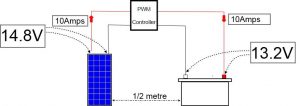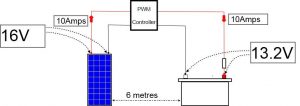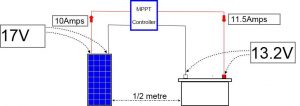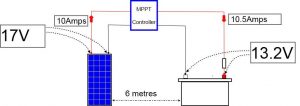The MPPT charge controller. Will it improve your solar panel system?
There has been a lot of discussion on-line about MPPT solar panel charge controllers. Will they improve the charge in your battery?
Are they good value for money?
We have been looking closely at the differences between PWM and MPPT charge controllers. Our special interest is in 12 volt solar panel systems, as used on motorhomes, boats and caravans. We have been working in this field since 1989!
Don’t worry, we will keep the technical stuff as straightforward as possible. Promise!
If you want to skip the technical stuff, click here….
So first, a bit about the solar panel.
It’s important to understand that the solar panel is primarily a current generator, not a voltage generator. To explain what this means let’s connect a solar panel directly to a battery and see what happens:
 We can see that the Sun is shining and the solar panel is producing a current of 10 amps which is flowing into the battery. The battery is only partially charged up and its voltage is 13.2 volts. (We are aiming to get the battery up to 14.4 volts). Notice that we have put the solar panel and the battery close together to keep the wires as short as possible.
We can see that the Sun is shining and the solar panel is producing a current of 10 amps which is flowing into the battery. The battery is only partially charged up and its voltage is 13.2 volts. (We are aiming to get the battery up to 14.4 volts). Notice that we have put the solar panel and the battery close together to keep the wires as short as possible.
The solar panel voltage is at 14.3 volts. This is because the current flowing along our cables generates a voltage which adds to the battery voltage. So the current flowing along the cable in this case has generated a voltage drop of 1.1 volts.
Note that the battery is a voltage generator and so determines the voltage of the circuit. The solar panel is a current generator and thus dictates the current flowing in the circuit. Electrically speaking, these two devices complement each other very well!
We are now going to introduce a PWM charge controller into the circuit.
Again, the solar panel is producing 10 amps and the battery voltage is 13.2 volts. But the voltage on the solar panel is now 14.8 volts. Why? Because the charge controller has also introduced a ‘voltage drop’ into the circuit. The total voltage drop is now 1.6 volts and this adds to the battery voltage to determine the solar panel voltage. Luckily, our solar panel is a current generator and is still happy to produce 10 amps and so the battery is still receiving 10 amps of charging current.
We will now move the solar panel and battery much further apart.
Our wires are now much longer. We will also introduce a fuse into the circuit together with some connectors. This is the typical setup found in a boat, motorhome or caravan.
As you can see, the solar panel is still producing 10 amps and the battery voltage is still at 13.2 volts. But the solar panel voltage is now at 16 volts. Why? Because the the wires, connectors and fuse introduce more voltage drops into the circuit. Adding all these voltage drops to the battery voltage means that the solar panel now operates at 16 volts.
This is not a problem for the solar panel. Remember that it is a current generator. It is happy to assume the voltage determined by the battery, wires, fuse and connections.
Up to a point!
Although the solar panel is a current generator, it still prefers to work at or below a voltage known as the ‘mean power point’ voltage. If the solar panel voltage happens to rise much above the MPP voltage it starts to become less effective. Not a problem for the setup above as the solar panel is working at 15.5 volts which is below the MPP voltage of 17 volts.
Let’s try the MPPT charge controller.
We have moved the solar panel and battery close together again, to keep the voltage drops as low as possible. MPPT charge controllers aim to keep the solar panel exactly at the MPP voltage.
So now we can see that the battery is at 13.2 volts and the solar panel is at 17 volts, the MPP voltage. The solar panel is still producing 10 amps but the battery is receiving 11.5 amps! The MPPT controller is able to convert the solar panel current into a higher battery current and so our battery will charge up a little faster. When the battery is close to the solar panel the MPPT controller will improve the charge into the battery. In this case the improvement is 15%.
So now let’s re-introduce the cables, connections and fuse.
Look what happens:
The current into the battery has fallen back to 10.5 amps. The previous improvement of 15% is now only 5%. Why is this?
Why did the MPPT charge controller struggle to work?
The MPPT controller itself introduces more voltage drop into the circuit due to the increase in complexity. It also needs more “voltage-overhead” to operate than the PWM controller due to the ‘switching’ circuit within the MPPT controller. So when the voltage drop along the cables becomes significant the MPPT cannot function as expected.
When the voltage overhead is not high enough for the MPPT to function correctly it reverts to PWM operation.
The MPPT controller also reverts to PWM operation when in absorption or float modes. During these two important charge modes the controller must reduce the current to the battery to avoid overcharging. So in these critical stages of charging the MPPT function has no benefit.
How can I use an MPPT charge controller?
- Keep the cables very short . Making the cables as short as possible will decrease the voltage-overhead and give the MPPT a better chance to improve the charge into your battery. The recommended maximum cable length is 5 metres. A PWM controller can work with a much longer cable length.
- Use heavier cables. This will also reduce the voltage-overhead. The recommended cable section is 6 mm sq. The cables needed for a PWM controller in the same situation can be just 2.5 mm sq., making the installation much easier.
- Use a solar panel with an MPP voltage of over 19 volts. This will provide more voltage-overhead for the MPPT controller to work.
- Choose a controller from a reputable manufacturer. Many of the low cost MPPT charge controllers currently available will not work as well as the example discussed in this article. Given the extra complexity of the MPPT charge controller, you need to think about reliability.
- In a 24 volt system. The voltage drops along the cables in a 24 volt system are much less significant than in a 12 volt system. MPPT controllers work well in 24 volt systems.
Is an MPPT controller worth the extra cost?
The extra cost of a good quality 15 amp MPPT controller, over a good quality PWM controller is about £35.
The average motorhome or boat will use about 6 metres of 2-core cable to install a simple solar panel system, more for a dual battery system. The thicker cables needed by the MPPT controller will cost an additional £18.
So the additional material costs of the MPPT controller are in the region of £53. This will give you a 5% improvement on your solar panel performance most of the time and a 15% improvement when conditions are right. If this extra money was spent on a larger solar panel the improvement would be 35% all of the time.
Conclusions:
A good quality MPPT charge controller installation will cost you about £53 more than a PWM system, and give you between 5% and 15% performance improvement, some of the time.
If this extra money was instead spent on a larger solar panel, the improvement in performance will be over 35%, ALL OF THE TIME.
Therefore a PWM controller on a 12 volt system is much better value for money, and there is less to go wrong.
Tel: 020 8144 2475
Email: [email protected]




